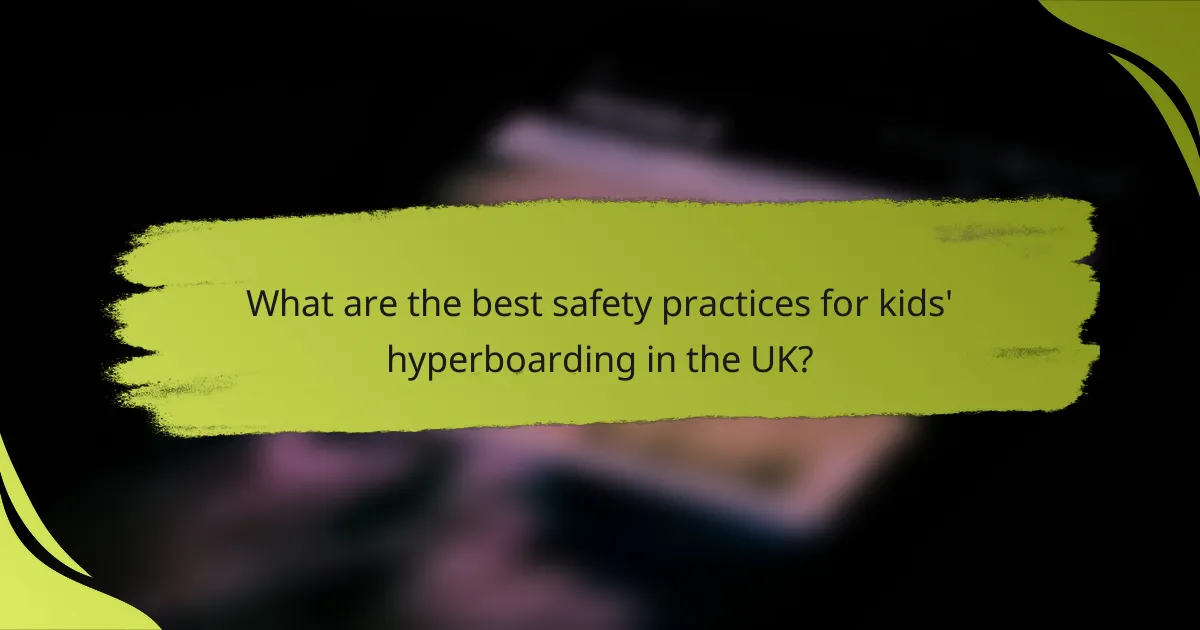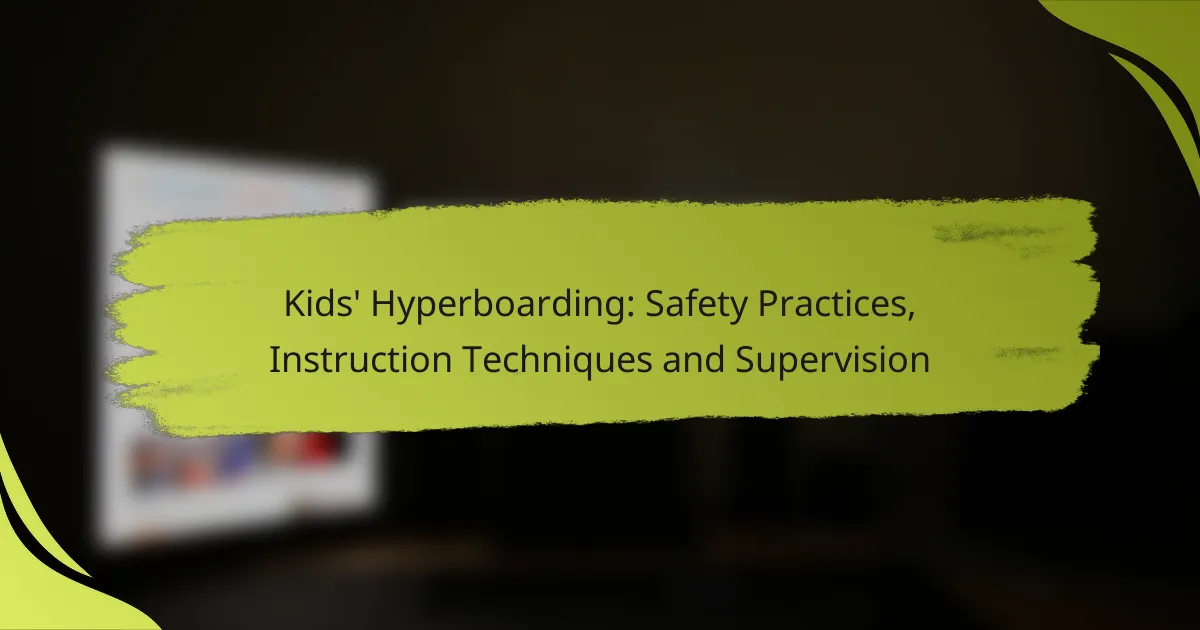Hyperboarding can be an exciting activity for kids, but safety must always come first. Implementing best practices such as wearing protective gear, selecting safe locations, and understanding weather conditions is essential for a secure experience. Additionally, proper instruction on balance and control, along with vigilant supervision, ensures that young riders can enjoy their time on the board while minimizing risks.

What are the best safety practices for kids’ hyperboarding in the UK?
The best safety practices for kids’ hyperboarding in the UK include wearing protective gear, choosing safe locations, understanding weather conditions, conducting regular equipment checks, and establishing clear boundaries. These measures help ensure a safer and more enjoyable experience for young riders.
Wearing protective gear
Wearing protective gear is essential for minimizing injuries while hyperboarding. Kids should wear a properly fitted helmet, knee pads, elbow pads, and wrist guards to protect against falls and collisions. It’s important to choose gear that meets safety standards, such as those set by the British Standards Institution (BSI).
Encourage children to wear their gear at all times, even during practice sessions. This habit helps them get used to the equipment and reinforces the importance of safety.
Choosing safe locations
Selecting safe locations for hyperboarding is crucial to avoid hazards. Look for smooth, flat surfaces away from traffic, such as parks, sports fields, or designated skate parks. Avoid areas with obstacles like curbs, rocks, or busy pedestrian paths.
Check local regulations regarding hyperboarding in public spaces, as some areas may have restrictions. Always prioritize locations that are well-lit and have enough space for kids to ride freely.
Understanding weather conditions
Weather conditions significantly impact safety while hyperboarding. Wet or icy surfaces can increase the risk of slips and falls, so it’s best to avoid hyperboarding during rain or snow. Windy conditions can also affect balance and control.
Before heading out, check the forecast and plan sessions for dry, calm days. If conditions change unexpectedly, be prepared to stop and seek shelter.
Regular equipment checks
Conducting regular equipment checks is vital for ensuring that hyperboarding gear is in good condition. Inspect the board for any signs of wear, such as cracks or loose parts, and ensure that wheels are properly secured and functioning. Regularly check protective gear for any damage that could compromise safety.
Establish a routine for these checks, ideally before each session. This practice helps identify potential issues early and keeps kids safe while riding.
Establishing boundaries
Establishing clear boundaries is essential for safe hyperboarding. Set rules about where kids can ride, how fast they can go, and when they should take breaks. Communicate these boundaries clearly to ensure that children understand the importance of safety.
Consider using visual markers or cones to define safe riding areas. This helps kids develop spatial awareness and reinforces the rules you’ve set, making the experience safer and more enjoyable for everyone involved.

How to instruct kids on hyperboarding techniques?
Instructing kids on hyperboarding techniques involves teaching them the fundamentals of balance, control, and safety. Start with basic skills and gradually introduce more advanced maneuvers as they gain confidence and proficiency.
Basic stance and balance
The basic stance is crucial for maintaining balance while hyperboarding. Kids should stand with their feet shoulder-width apart, knees slightly bent, and weight evenly distributed on both feet. This position helps them stay stable and react quickly to changes in terrain.
Encourage kids to practice balancing on the board while stationary before moving. A good exercise is to have them shift their weight from one foot to the other to develop a sense of equilibrium.
Starting and stopping methods
To start hyperboarding, kids should push off with one foot while keeping the other foot on the board. A gentle push can help them gain momentum without losing balance. It’s essential to practice this motion in a safe, open area.
Stopping can be achieved by dragging one foot on the ground or using a heel brake if the board is equipped with one. Teach kids to practice stopping frequently to build confidence and ensure they can control their speed effectively.
Turning and maneuvering
Turning on a hyperboard requires shifting weight and leaning in the desired direction. Kids should practice gentle turns by leaning their shoulders and hips while keeping their feet planted. This technique allows for smoother transitions and better control.
Encourage them to practice wide turns before progressing to sharper angles. Using cones or markers can help them visualize their path and improve their maneuvering skills.
Advanced tricks and skills
Once kids are comfortable with basic techniques, they can start learning advanced tricks like ollies or grabs. These tricks require practice and should be introduced gradually to avoid injury. Ensure they wear protective gear, including helmets and pads, during these sessions.
Consider setting up a safe environment, such as a skate park or a designated area with soft surfaces, to practice these skills. Supervision is key, as it allows for immediate feedback and ensures safety while they explore new techniques.

What supervision is required for kids’ hyperboarding?
Effective supervision is crucial for ensuring the safety of kids while hyperboarding. Adults and peers must work together to monitor activities, enforce safety practices, and respond to emergencies.
Adult supervision guidelines
Adults should always be present when kids are hyperboarding, especially in unfamiliar environments. They must be knowledgeable about the sport, including safety gear requirements and local regulations.
Establish clear rules and boundaries for hyperboarding areas, ensuring that kids understand where they can and cannot go. Regularly check that all equipment is in good condition and that safety gear, such as helmets and pads, is worn at all times.
Peer supervision strategies
Encourage kids to look out for one another while hyperboarding. They can form small groups where they take turns watching each other’s activities, ensuring that someone is always aware of potential hazards.
Teach kids to communicate effectively about safety concerns, such as warning each other about obstacles or unsafe conditions. Establish a buddy system where each child is paired with another to enhance accountability and support.
Emergency response planning
Prepare for emergencies by having a clear plan in place. Designate a safe meeting point for kids to gather in case of an incident and ensure they know how to reach it.
Adults should familiarize themselves with basic first aid procedures and have a first aid kit readily available. Regularly review the emergency response plan with the kids, so they know what to do in case of an injury or accident.

What are the prerequisites for safe hyperboarding?
Safe hyperboarding requires specific prerequisites, including appropriate age, skill level, physical fitness, and familiarity with the equipment. Meeting these criteria helps ensure a safer and more enjoyable experience for young riders.
Age and skill level considerations
Age and skill level are crucial factors in determining a child’s readiness for hyperboarding. Generally, children should be at least 8 years old and possess basic balance and coordination skills. Younger children may struggle with the demands of hyperboarding, which can lead to accidents.
It’s important to assess each child’s individual skill level. Beginners should start with basic techniques and gradually progress to more advanced maneuvers as they gain confidence and experience. Regular practice can help improve their abilities and safety awareness.
Physical fitness requirements
Physical fitness plays a significant role in a child’s ability to safely participate in hyperboarding. Kids should have a reasonable level of strength, flexibility, and endurance to handle the physical demands of the sport. Activities like running, cycling, or swimming can help build the necessary fitness levels.
Before starting hyperboarding, parents should evaluate their child’s overall health and fitness. If a child has any pre-existing conditions or concerns, consulting a healthcare professional is advisable to ensure they are fit for the activity.
Equipment familiarity
Familiarity with hyperboarding equipment is essential for safety. Children should understand how to properly use and maintain their boards, including adjusting straps and checking for wear and tear. Taking time to learn about the equipment can prevent accidents caused by malfunctioning gear.
Parents should supervise initial practice sessions to ensure that children are comfortable with their equipment. Teaching them how to perform basic checks before each use can instill good habits and enhance their overall safety while hyperboarding.
